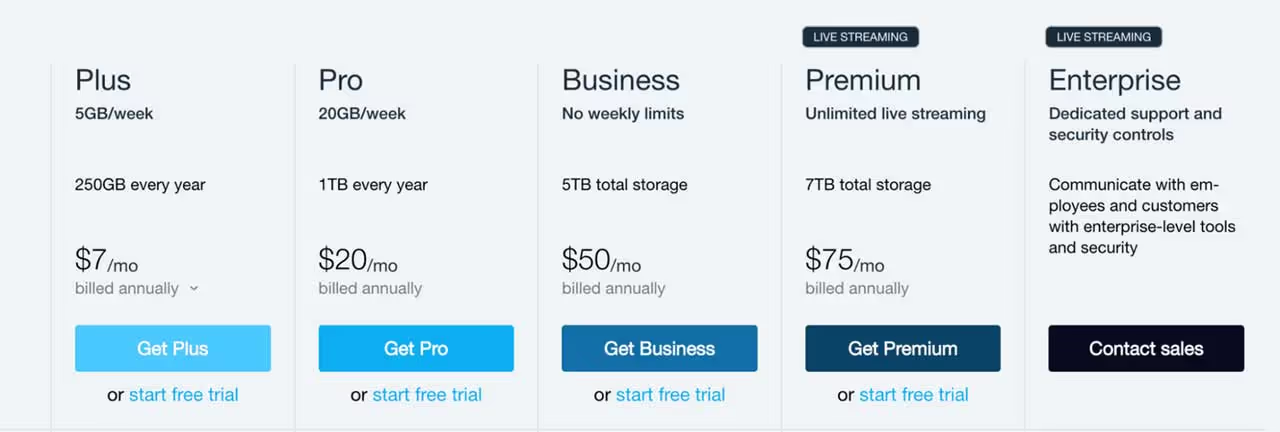Table of Contents
When discussing the best platform for video uploads, YouTube probably comes first in your mind. However, there are still some creators who prefer to use Vimeo. As a content creator who wants to get serious and build branding online and wants to monetize your content, which platform is the best, YouTube or Vimeo?
To help you find the best solution for your business's specific needs, we've put together a head-to-head comparison between YouTube and a smaller, niche platform, Vimeo, based on a number of factors. Read on to see the results and decide for yourself.
Vimeo vs YouTube: Key Differences
1. Community
YouTube has more than two billion users worldwide. In comparison, Vimeo only has 240 million active users each month. However, the number of users is not the only consideration.
YouTube offers a convenient and cost-free platform for hosting and sharing a wide range of videos, encompassing everything from product demonstrations and podcasts to dance performances and personal videos. Given its enormous user base and potential exposure, it's no surprise that many content creators opt for YouTube as their video hosting solution.
However, the sheer volume of content uploaded to YouTube every minute 500 hours' worth poses a significant challenge in terms of standing out and reaching one's intended audience.
On the contrary, Vimeo boasts a smaller but more specialized community, providing videos with a higher likelihood of being discovered by a larger number of people, particularly the right target audience. This is why businesses, filmmakers, videographers, visual artists, art directors, and other professional creators are increasingly gravitating towards this platform. Not only can they receive valuable feedback from fellow professionals in their field, but they can also actively engage with them.
In summary, Vimeo may have a smaller community compared to YouTube, but it is more robust, focused, and pertinent to the needs of content creators.
2. Content Type

YouTube's extensive user base acts as a magnet for video creators worldwide, resulting in a vast array of content across the platform. From instructional videos and personal vlogs to sports highlights and movie trailers, YouTube offers a diverse range of content types. In the past decade, internet personalities have risen to fame, with many of them launching their careers on YouTube. These content creators have amassed unprecedented numbers of subscribers, becoming some of the most influential figures in pop culture.
The content landscape on YouTube is truly unparalleled, setting it apart from any other competing platform and solidifying its position as the internet's foremost video-sharing service.
On the other hand, Vimeo's content differs significantly. As mentioned earlier, it predominantly serves as a platform for professionals to share and showcase high-quality videos within a community that values honest feedback. Consequently, Vimeo is not the place to find teenage vloggers with millions of subscribers; its environment caters more to serious creators and artistic endeavors.
3. Revenue Model

Both platforms employ distinct approaches to generate revenue. As previously mentioned, Vimeo offers four premium subscription plans, with prices ranging from $7 to $56 per month (currently discounted from the usual $75 per month rate). Each subscription plan provides users with varying levels of data storage, business tools, analytical tools, personalization options, and privacy features. While there is a free subscription plan available, it is limited and not intended for the business-related usage that most Vimeo users seek. As an ad-free platform, Vimeo derives its entire revenue from membership fees.
On the other hand, YouTube relies on advertisements as its primary source of income. Through the YouTube Partner Program (YPP), creators can earn revenue from ads displayed before, during, and after their videos. This presents an opportunity for advertisers to promote their products and services to viewers.
Contentcreators on YouTube receive more than half (55%) of the ad revenue. However,reaching the threshold for monetization requires a channel to accumulate 4,000hours of watch time, which may necessitate creating a significant number ofvideos before earning money through the YPP. Additionally, the earnings varysignificantly based on the creator's country.
Aside from the YPP, YouTube creators can explore additional avenues for monetization. They can join affiliate programs, solicit donations from their audience, and create sponsored content in collaboration with brands. Furthermore, YouTube offers a premium subscription service that allows subscribers to enjoy an ad-free viewing experience. Creators can receive payment based on the subscriptions of premium users.
Channel memberships provide another monetization option, enabling viewers to join a creator's channel through monthly payments. In return, members gain access to exclusive content and features such as live chats, streams, custom emojis, and more.
In summary, Vimeo generates revenue through membership fees, while YouTube primarily relies on advertising through the YPP. However, YouTube creators have the opportunity to explore additional monetization avenues such as affiliate programs, donations, sponsored content, premium subscriptions, and channel memberships.
4. Ease of Use
YouTube is a widely-used platform for hosting content, providing creators with a simple and straightforward method to upload and share videos with their audience. The process of uploading videos on YouTube is user-friendly and requires minimal effort.
To begin, ensure that you are logged into your YouTube account and click on the upload button. Select the desired file you wish to upload, and while the video is being uploaded and processed, provide essential information such as the title, tags, descriptions, and privacy settings.
Once the video is uploaded and shared with your audience, you can conveniently access comprehensive video analytics through a dashboard. This includes valuable insights such as the number of views, subscriber count, watch time, and more, enabling you to monitor the performance of your content.
Moving on to Vimeo, the process of uploading videos on this platform is similar to that of YouTube. Sign in to your Vimeo account, choose the video you want to upload, add the appropriate title, tags, and description, update the privacy settings according to your preferences, and wait for the video to finish uploading. However, it's worth noting that Vimeo's upload guidelines are stricter compared to YouTube, as the platform prioritizes the quality of videos over quantity.
Also read: Choosing Short-Form vs. Long Form. Video Content: Which Work Best for You?
5. Cost
YouTube offers a free service for both individuals and businesses, allowing users to upload and share an unlimited number of videos without any cost. Additionally, YouTube provides users with unlimited storage space for free. This makes YouTube an excellent choice for content creators who have budget constraints.
However, does Vimeo also offer a free service? Vimeo follows a different pricing model compared to YouTube. While Vimeo does offer a free basic plan, it comes with certain limitations. Users on the free plan have a maximum upload space of 500 MB per week and a total storage limit of up to 5 GB. Additionally, Vimeo offers four different plans for businesses: Plus, Pro, Business, and Premium. Each plan comes with distinct upload limits and features. Moreover, for the business plans, Vimeo offers a 30-day trial period, allowing users to assess whether the plan is suitable for their needs.
6. SEO Support

When comparing YouTube and Vimeo, YouTube holds a significant advantage in terms of search engine optimization (SEO) due to its status as the second-largest search engine globally, right after its parent company, Google. Google tends to prioritize videos from YouTube over those posted on other platforms.
Forinstance, if you're searching for the best video editing software, a quickGoogle search will likely display YouTube videos as the top results.
Therefore, if your video content is specifically tailored to target certain search queries, such as "how to color grade," YouTube should be your platform of choice. This is because your videos will not only appear in search results on YouTube but also on Google, ultimately driving organic traffic to your content.
On the other hand, Vimeo videos do appear in Google searches, but to a lesser extent compared to YouTube. While you can enhance the SEO of your Vimeo videos by adding descriptions and alt tags, it is challenging to achieve the same level of reach that you would obtain on YouTube.
7. Upload and Storage Limit

YouTube allows users to upload videos with a maximum duration of 15 minutes. However, for verified YouTube accounts, the upload limit is extended, allowing videos longer than 15 minutes and up to 12 hours in length. The maximum file size for uploads on YouTube is 128 GB. Notably, there is no restriction on the number of videos you can upload on YouTube for free. If you need to create videos up to15 minutes long, In Video's YouTube video editor provides a convenient solution.
In terms of storage, YouTube offers unlimited and free storage for all user accounts. This is an advantageous offering, particularly for content creators with budget limitations.
On the other hand, Vimeo implements varying upload and storage limits based on its different business packages.
Both platforms have distinct guidelines concerning the amount of content users can upload and store. YouTube, being entirely free, presents a formidable challenge for Vimeo to compete with. However, if you have high requirements for content upload and storage, Vimeo becomes a more favorable choice.
Which One Should I Use?
When making the decision to upload your videos either on YouTube or Vimeo, it's crucial to consider the purpose and nature of your content. While YouTube offers the potential for viral reach and a diverse viewership, the sheer volume of content on the platform means that your videos can easily get lost amidst the vast sea of videos available. On the other hand, Vimeo provides greater control over who can access your work and offers more customization options for reaching your desired audience.
For professionals seeking to showcase their work with an emphasis on visual quality, Vimeo is the ideal choice. It allows you to maximize the visual appeal of your content and offers a high-quality sharing platform for posting and embedding videos.
However, if your primary goal is to share your content with a wide audience, regardless of its nature, YouTube is the platform to consider. With countless success stories stemming from YouTube, its user-friendly and straightforward platform provides both experienced and inexperienced creators with the opportunity to potentially go viral, even with minimal equipment or experience.






